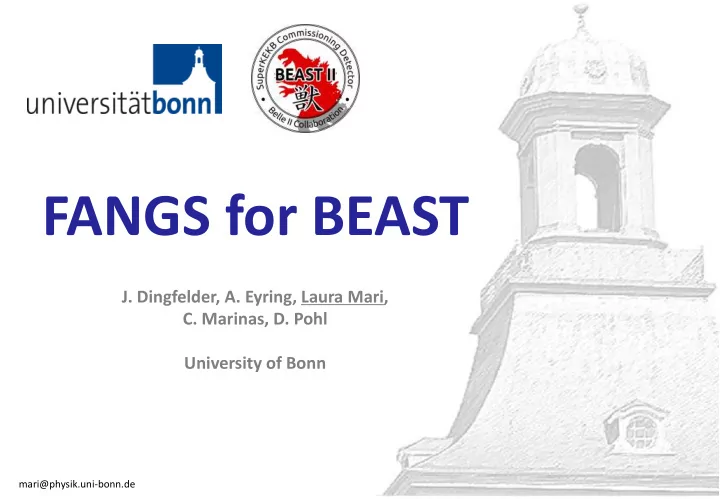

FANGS for BEAST J. Dingfelder, A. Eyring, Laura Mari, C. Marinas, D. Pohl University of Bonn mari@physik.uni-bonn.de 1
FANGS: FE-I4 ATLAS Near Gamma Sensors • FE-I4 read out chip High hit rates and radiation hard IBM 130 nm CMOS process Provides read out for 80x336 pixels Thickness=150 µm Physical size= 21x19 mm 2 Bump bonded to Si sensor • Sensor: n-in-n planar Pitch= 50x250 µm 2 Thickness=200 µm Physical size=19x20 mm 2 HV=60 V Power=1.2 W • Background radiation measurements in Phase 2: • Sensitive to low keV X-rays (6 keV to 60 keV) • Particle rates (25 ns) mari@physik.uni-bonn.de 2
TDC Method V(Q) t 1 t 2 V th TOT Time TOT Clock signal TDC Clock signal • Two stage amplifier → Discriminator with adjustable threshold. • Time over threshold (TOT) with externally supplied 40 MHz clock. • Time to digital converter (TDC) uses 640 MHz FPGA clock. • Output of each pixel is ORed. • Internal charge injection circuit for threshold tuning and calibration → Both, high speed and adequate energy resolution achieved at the same time mari@physik.uni-bonn.de 3
Experimental Setup Hit-or Production module FPGA Adapter Data FE-I4 Adapter Multi IO Open card Board drain Buffer HV • USBpix used for readout and pyBAR for analysis. • Open drain buffer amplifies HitOr signal on long cables ( Ο (30 m)). • New USBPix3 readout system being tested at the moment (8 FE at a time). • Software allows to monitor multiple FE in parallel. mari@physik.uni-bonn.de 4
Pixel-per-pixel Calibration • Threshold tuning noise based • Vth and TDC as a function of charge different for each pixel. • Per pixel calibration needed. • Internal charge injection in units of PlsrDAC ~ 55 electrons mari@physik.uni-bonn.de 5
Calibration and Dynamic Range • Wide dynamic range covered (wider also possible) • Lowest measured plsrDAC value ~ 7 • Threshold of ~ 1000 electrons feasible mari@physik.uni-bonn.de 6
Energy Resolution 3D sensor • Terbium K α =44.23keV, K β =50.65 keV • Adequate energy resolution • ΔE = 6.42 keV • Better than 15 % above 10 keV mari@physik.uni-bonn.de 7
Initial Design Concept for Beast II • Stave structure similar to ATLAS IBL. • 90 µm thick flex attached on top of sensor for read out. ↘ BUT: High absorption probability in the low keV range → Forced a design change mari@physik.uni-bonn.de 8
Flex Radiography mari@physik.uni-bonn.de 9
FANGS Stave: Design Evolution Connector • How to mount few single chips in Phase 2? Support+Cooling (Reusing existing infrastructure) FE-I4 Sensor Flex Wire bonds • Move the flex to one side. No material in front! Support+Cooling Flex FE-I4 Sensor Wire bonds • Thinner support. Make use of PXD cooling Support+Cooling Flex FE-I4 Sensor Wire bonds mari@physik.uni-bonn.de 10
Mechanical Arrangement SIDE TOP Al Glue FRONT FE-I4 Flex Solder Sensor Wire bonds mari@physik.uni-bonn.de 11
FANGS and CLAWS Integration CLAWS FANGS • Final configuration under discussion • Established regular Bonn-MPI meetings CAD integration by K. Ackermann (MPI) BASF2 implementation M. Ritter (KEK-MPI) mari@physik.uni-bonn.de 12
Flex Concept Design still evolving: • 8 mm wide Kapton • 2 x 40 pin connector on backward side • Short intermediate Kapton connecting to a PCB attached to SVD ring • 4 Ethernet and 1 power connectors on PCB mari@physik.uni-bonn.de 13
Aluminum Stave Material Budget • Support: 3 mm thick Aluminum → 3.4%X 0 • Epoxy: Aluminum 50 µm thick → 0.014%X 0 Glue FE-I4 • FE-I4 Flex 150 µm thick → 0.16%X 0 Solder Sensor • Sensor: Wire bonds 200 µm thick → 0.21%X 0 • Solder balls 3.1% X 0 3.9% X 0 SnAg → 0.17%X 0 (3.3% of the area) • Flex (or 500 µm PCB) • Low and flat material budget distribution 66 µm thick polymide → 0.023%X 0 • No impact in outer detectors 24 µm Cu (2 layers) → 0.17%X 0 Reminder: PXD+SVD contribute with ~4.0% X 0 mari@physik.uni-bonn.de 14
FEA of a FANGS (Al-based) Stave • Maximum temperature = -4 º C • Maximum Δ T within one sensor = 4 º C • Power = 1.2 W each FE • Proper heat handling • • Cooling block = -15 º C Low and flat temperature profile • Environment = 20 º C at 2 m/s mari@physik.uni-bonn.de 15
Conclusion • FANGS is rapidly evolving into a final detector system for background (energy and rates) measurements at BEAST Phase 2 • All the aspects related to the design, characterization, integration are in good progress • 30 hybrids (FE-I4 and planar sensor) have been prepared (twice what is needed) • Front end has been tuned to cover the expected energy range with proper resolution • Multiple-FE DAQ with long cables is being tested with a new readout system • Kapton flex and intermediate boards are being designed • Mechanical concept and cooling management are well in progress mari@physik.uni-bonn.de 16
Thank you mari@physik.uni-bonn.de 17
Recommend
More recommend